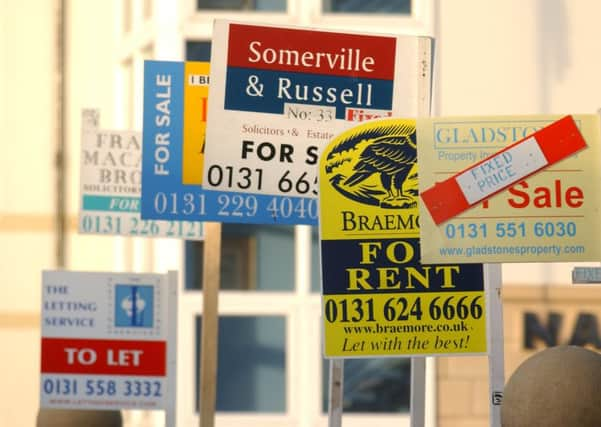This is what’s causing Edinburgh’s housing crisis – Professor Cliff Hague


For around half a million people, Edinburgh is a place to live. For thousands more, it is a place for work even if they choose to live outside the city itself, or cannot access suitable housing within the city.
Homes for Scotland, which represents housebuilders, says that Edinburgh is the least affordable city in Scotland, with average house prices 6.12 times average earnings.
Advertisement
Hide AdAdvertisement
Hide AdRenting has also become increasingly expensive. The Scottish Government has reported that between 2010 and 2018, the average rent for a two-bedroom property in Lothian increased by 42.3 per cent, more than double the average rate of increase in Scotland, at a time when the incomes of low earners have hardly risen in real terms.
Last year Grant Property reported that an astonishing 75 per cent of house buyers in Edinburgh are from outside Scotland, adding that they expect the trend to continue. Savills, another big estate agency, has commented that Edinburgh tenement flats are considered good value by Middle Eastern investors interested in property hotspots such as Leith. If these trends continue, who will Edinburgh be for in ten years’ time?
The Cockburn Association’s “Our Unique City” public consultation initiative believes that all the citizens should have a say on the future of Edinburgh as a place to live. We need to look beyond the housebuilders’ advocacy on housing numbers, which drives our planning system. Qualitative concerns about whom and what housing is for, and what makes a good place to live should be addressed for both new and existing neighbourhoods.
“Affordable housing” takes many forms from traditional social renting to mid-market rents, shared ownership and discounted sales. The need for more affordable housing is widely accepted, the challenge is how to provide it.
Like other authorities, Edinburgh relies substantially on asking developers to contribute to affordable housing provision. The council, as planning authority, operates a policy that “Planning permission for residential development, including conversions, consisting of 12 or more units should include provision for affordable housing amounting to 25 per cent of the total number of units proposed. For proposals of 20 or more dwellings, the provision should normally be on-site”. Housing associations are often involved in building and managing the affordable element.
Much of the land on which houses will be built in the next decade already has planning permission, but development will only take place at a time, and on conditions acceptable to, landowners and housebuilding companies. It will be very difficult to get them to provide the scale of affordable housing the city needs – that is not their priority. Should more ambitious targets for affordable housing be set on new planning permissions, or would this prompt housebuilders to ‘go on strike’? This is urgent because large sites at Astley Ainslie and Redford Barracks, for example, are expected to be the subject of major planning applications, as publicly owned land is sold off.
The UK now has some of the smallest new homes in Europe. Analysis in 2017 from Sellhousefast.uk found the average new three-bedroom home in England measured 88 metres squared. The Netherlands and Germany average at 115.5m2 and 109.2m2 respectively, Denmark 137m2. This “shoe-box house squeeze” is most severe at the lower end of the market, exacerbating other inequalities. Most large-scale housebuilders use standardised plans, so this trend is likely to be evident in Edinburgh too. Should this be a concern for public policy here?
The market in short-term holiday rentals through platforms like AirBnB has mushroomed, largely unregulated. A Cockburn Association report last year showed that this has reduced the supply of affordable accommodation. Rental income from short-stay visitors exceeds that from long-term tenants, and obligations on property owners are much less. There are also issues of amenity, particularly in tenement properties, with “party flats” an obvious nuisance. Tracing owners for common repairs becomes more problematic, undermining good property maintenance. The problems are most severe in the Old Town and Leith, but not confined to those locales.
Advertisement
Hide AdAdvertisement
Hide AdStudent housing development is also eroding access to affordable housing. Again, the market incentive is simple: higher rents and less onerous requirements. As universities have become big business, they compete to attract students, and especially high-fee overseas students, through their “student experience offer”, part of which is accommodation. However, with online tuition and a growing “gig economy”, is this model of higher education and the student housing it promotes sustainable? What planning policies might Edinburgh adopt to stem the loss of affordable housing?
Reliance on big housebuilding companies is reducing Edinburgh’s distinctiveness, as they lay out another estate of standard “luxury executive” houses. A recent report in England criticised developments at very low densities in locations where the car is the only realistic means of transport, with wide roads, driveways, garages and parking areas, but skimping on open space. Should Edinburgh, and the Scottish Government who will determine the inevitable planning appeals, be demanding more?
As council finance has been squeezed, planning departments have been expected to negotiate developer contributions for infrastructure and social facilities. Edinburgh currently sets out what it expects in relation to a list of different zones in the city. In many cases it is simply a matter of setting a price which the developer can then negotiate around. Is this producing the kind of living environments we want for the future?
Last autumn Edinburgh City Council held a consultation on “placemaking”. While welcome, it was led by a focus on transport rather than planning and design. Successful placemaking should be holistic, encompassing trees and the natural environment, conservation of environmental assets and landmarks, reuse of existing building, and future adaptability of places in relation to the climate crisis. How can these important principles be embedded in planning locally and nationally, and enforced? Let’s hear your views.
Professor Cliff Hague is chair of architectural conservation body The Cockburn Association
